Mormon's Map Puzzle Solved?
by John P. Pratt
Reprinted from Meridian Magazine (12 Dec 2006).
©2006 by John P. Pratt. All rights Reserved.
Index,
Home
A detailed map for the Book of Mormon has been produced by archaeologist
Garth Norman which may solve a long-standing puzzle.
Haven't you always wanted to have a detailed map of just where everything is in the book of
Mormon? After all, when you read the Bible, you can turn to the maps and see where everything
happened. In fact, you can go and visit most of those places today. Wouldn't it be wonderful to
have maps in the Book of Mormon where we could follow the action as we read? Unfortunately,
we have never had a detailed map where we can point with confidence to just where the land of
Manti or the River Sidon was. Until now, we have had maps made by a variety of Book of
Mormon scholars which showed general areas, but with very few precise locations pinpointed.
Now that has changed.
This article reviews a new map which indicates some 76 detailed items, complete with Book of
Mormon textual references for each. It comes with an optional explanatory booklet entitled Book
of Mormon - Mesoamerican Historic Geography, and is available online in time for Christmas.[1]
It was produced after forty years of research by archaeologist V. Garth Norman, who has
advanced degrees in both archaeology and ancient scripture, and it looks excellent. It appears that a
new day in Book of Mormon geography is now dawning. Let us review briefly some of the key
anchor points used by most scholars for their proposed maps, and then focus on one particular
puzzle that Norman has found a brilliantly creative solution for.
1. Map Anchors
How can one go about discovering where it was in the Americas that the history recorded in the
Book of Mormon took place? One way is a step-by-step "anchoring" method where one builds
stone by stone on a firm foundation. First one lays some solid cornerstones that are key anchor
points, fills in more points that are known relative to them, and then all of the final details.
It is like putting together a jig-saw puzzle. How does one start? One reliable method is to find the
four corner pieces first, then complete the four borders, and then build in from there to complete
the puzzle. In my work to determine religious chronology I did likewise, first determining fixed
anchor points such as the date of the resurrection of Christ and fall of Jerusalem, and then
reckoning from there to get more anchor points.
1.1 Limited Extent
Distances in the Book of Mormon are given in terms of days of travel. Moreover, many named
cities are mentioned, sometimes with their approximate directional relationship to others. When one
looks at the time stated to travel all the way from the southernmost part to the north, it is only a matter of weeks (Mosiah 23:3,20,25), which implies that the greatest dimension of the entire area is only a few hundred miles.
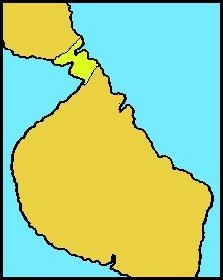 |
Figure 1. A land nearly surrounded by water.
1.2 Narrow Neck of Land
The best summary of the overall description of Book of Mormon geography is given by Mormon
himself in preparation for describing some detailed wars (Alma 22:27-34). One very distinctive
feature he mentions is that there was a Land Northward and a Land Southward separated by a
narrow neck of land. Thus, we are looking for two lands separated by an isthmus. There are
many such places in the western hemisphere, so we need to look for more clues.
1.3 Nearly Surrounded by Water
Another huge clue provided by Mormon is that the Land Southward was "nearly surrounded by
water" (Alma 22:32). It had seas to the east, south, west and north (Helaman 3:8). No doubt it
was for that reason that some of the first who arrived with Lehi's group believed that they were on
an island (2 Nephi 10:20). Now this added information really limits possibilities, even without archaeological finds. Figure 1 shows a map drawn by J. N. Washburn in 1968 showing these two key features, without attempting to refer to any specific known location.[2]
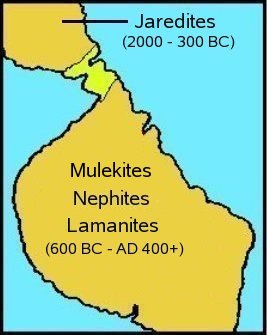 |
Figure 2. Location of Book of Mormon peoples.
1.4 Two Advanced Cultures
The Book of Mormon describes two main groups who migrated from the Eastern Hemisphere to
the Western at very different times to different places. The first group, called Jaredites, left from the Tower of Babel
(about 2000 BC), migrated north, crossed an inland sea (most likely Caspian Sea), continued on
(most likely to China), and then crossed the great waters (Pacific) to come inhabit the Land
Northward of the Narrow Neck. The other group (consisting of both Lehi's and Mulek's separate
migrations) came from Jerusalem about 600 BC. We are only told that Lehi's route was basically
to cross Arabia and then the Pacific to land in the Land Southward. During most of the period
described in the book of Mormon, both Lehi's descendants (the Nephites and Lamanites) and also
the Mulekites lived in the Land Southward. For the period of about 400-200 BC they were in three
distinct areas of that land, with the Mulekites northernmost, the Nephites in the middle, and the
Lamanites in the southern part, where Lehi first landed. Around 300-200 BC the Jaredites had a
huge internal civil war in which that civilization was largely destroyed. Around AD 400 the
Lamanites destroyed the Mulekites and Nephites who had stayed in that area. Figure 2
shows the approximate arrangement on Washburn's map.
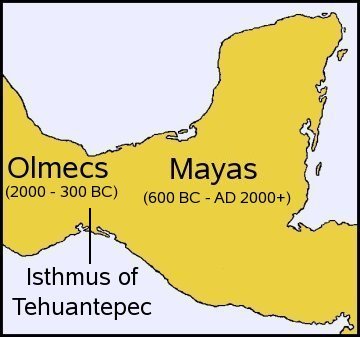 |
Figure 3. Mesoamerica archaeology fits.
Here is where the science of archaeology provides a great clue to locate the Narrow Neck because
we know we are looking for an isthmus separating two civilizations and we know the time periods
in which they existed. Given this information, there is one isthmus which jumps out as being the
clear front runner. It is the Isthmus of Tehuantepec in Mexico. Just northward of that Narrow
Neck lived the Olmecs from about 2000 - 300 BC and south of it lived the Mayans from about 600
BC until the present day. Moreover, the land southward is nearly surrounded by water. That is a
perfect match of time and place (see Figure 3). This identification was first emphasized by M.
Wells Jakeman, first head of the BYU Department of Archaeology from 1946-1960. It has become
known as the "Limited Tehuantepec Theory."[3] Today, nearly all researchers agree with this
identification.
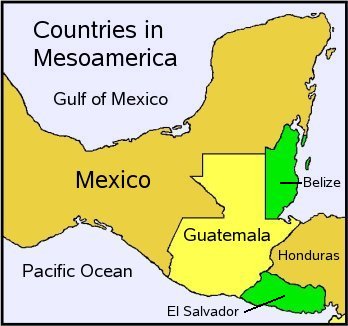 |
Figure 4. Modern Mesoamerican countries.
This area comprises the southern part of Mexico and the northern countries of Central America of
Guatemala, Belize, Honduras, El Salvador and part of Nicaragua as shown in Figure 4.
1.5 Narrow Wilderness Strip
Now we begin to look at important features about which there is more disagreement among Book
of Mormon scholars. The most important is probably the location of a strip of wilderness which
ran all the way from the East Sea to the West Sea (Alma 22:27), that is, from the Atlantic to the Pacific Ocean. At about 100 BC, this strip separated the Nephites and Mulekites on the north
from the Lamanites on the south. It was important strategically for the Nephites to close off their
south border to keep the Lamanites from overrunning their land. Captain Moroni had seven cities
fortified along this strip for that purpose.
It is fortunate for us that the strip had strategic military importance to the Nephites because that
likely caused this important clue to be included in the record. What was the nature of the
"wilderness"? Does that only refer to uninhabited jungle areas? One clue is that Moroni only had to
fortify cities at certain locations on the strip in order to secure it, so it must have been difficult to
cross at other places. Before looking for it, let us look at one more clue.
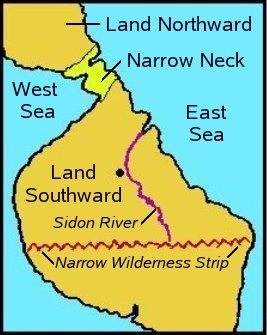 |
Figure 5. Mormon Geography Map.
1.6 River Sidon
The only river described in the Book of Mormon is the River Sidon. It was a large enough river to throw thousands of corpses in after a battle and have them easily wash out to the sea. It is important in the history because the great city of Zarahemla, the capital of the Nephite/Mulekite civilization after they merged, was just west of the Sidon. An important geographical clue is that the head waters of the Sidon were located at the Wilderness Strip (Alma 22:29). That tells us two
things. First, that area of the Wilderness Strip is mountainous, because mountains are where rivers begin. Secondly, because the strip is east-west, then at least part of the Sidon flows north, away from the mountains. Figure 5 shows Washburn's placement of the river, along with my addition of the wilderness strip and the city of Zarahemla.
 |
Figure 6. Narrow Wilderness Strip(s).
There are not very many places in the western hemisphere where one can find a mountain range
that runs all the way from the Atlantic to the Pacific. The major mountain ranges tend to run north to south. This feature is so distinctive that it might have been used as the very first criterion for location. When we look at the proposed location we find not one but two possible mountain ranges that run nearly continuously from ocean to ocean, as shown in Figure 6. Some researchers favor one range and some the other, and some both together forming the strip.[4]
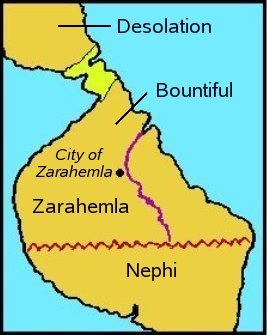 |
Figure 7. Names of Large Areas.
1.7 Names of Large Lands
In Mormon's description of the area, he provides the names of the large areas on the map. The part
of the Land Northward near the Narrow Neck was called Desolation and Bountiful was found just
southward of it (Alma 22:30-31). South of that was the land of Zarahemla, which was separated
from the Land of Nephi in the far south by the wilderness strip (Alma 22:34). These areas are
indicated on both maps in Figures 7 and 8. Now let us turn to the puzzle.
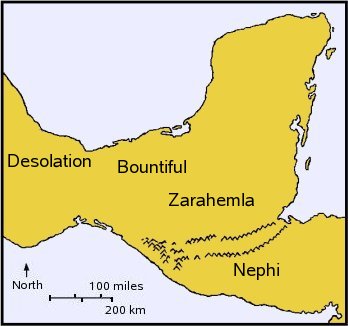 |
Figure 8. Names of Large Areas.
2. Limhi's Expedition
Before looking for the River Sidon, the next important landmark to identify, let us turn to one
"puzzle" which the Norman map and explanatory booklet appears to solve. There are actually
many puzzling aspects of Book of Mormon geography, but there is one which has been a "litmus
test" for me in deciding whether or not a proposed map has a chance of being correct. Allow me to
state it as a formal logic puzzle, which you may now try to solve yourself before reading Norman's
solution.
The puzzle is to draw the River Sidon, as well as the location of the city of
Zarahemla, on a Book of Mormon internal map (such as in Figure 7, or your own), in a way to
explain the following weird result of the "Limhi expedition" (Mosiah 8:7-11, 21:25-26). To me this account is difficult to explain on any map at
all, so finding a solution on a real map would be compelling evidence both for the Book of
Mormon being a true record, as well as the river and city being correct. This is to be done strictly
as a puzzle; of course any real solution would need to correlate with archaeological finds and all the
other internal details from the Book of Mormon account. Now consider the details of the puzzle
that you need explain.
2.1 The Puzzle
There was a king named Limhi who lived in the southern part of the Land Southward, called the
Land of Nephi. His city was in bondage to the enemy Lamanites, so he sent an expedition to get
help from the great city of Zarahemla from which his grandfather had come. It was known to be
just west of the River Sidon, and that river was known to have its headwaters not far north of them
in the Wilderness Strip. Even though this new generation might never have been there, it
hopefully wouldn't be too difficult to find given that information, and the approximate length of
time needed. But what happened seems mysterious indeed.
The expedition got lost (not too hard in a jungle region), found a land of many waters, and a city
that they thought was indeed Zarahemla (Mosiah 21:26). But alas, the city had been destroyed
long enough ago that they found only dry bones and rusted swords and armor. They were so
strongly convinced that they had found Zarahemla, that they returned to King Limhi with the bad
news. Nothing is mentioned about getting lost on the way home, so apparently that was not a
problem.
Now for the puzzling part. The destroyed city they found was in, or beyond, the narrow neck of
land, in the part of the Land Northward later called Desolation, which was separated from
Bountiful in the Land Southward by the Narrow Neck (Alma 22:30-32), as shown in Figure 7. The puzzle is to draw their route and explain just how these trained scouts could have mistaken the destroyed
city for Zarahemla. A solution must include 1) what they probably knew about what they were
looking for, 2) what their plan had been to find it, 3) where the land of many waters was and why
it was included, 4) how the destroyed Jaredite city would have met their criteria, 5) why at no point
did they know that it was not Zarahemla, and 6) what their return route was. Just a note here from
puzzle theory: there are several logic puzzles whose solution is based on the clue that an intelligent
person was baffled by something.[5] In this case we must explain how the search party had no
clue that it was not Zarahemla and enough reason to think that it was to return and report.
Okay, time to stop reading this article and go do the puzzle yourself. Simply draw any map with
all of the required elements (something like Figure 7) and draw in your proposed solution of just
where the expedition might have gone.
Well, how did you do? Most probably you had a difficult time. The reason the question was posed
here as a formal puzzle is that it is nearly impossible to come up with any good solution using the
map of Figure 7. No matter how one draws a false route from Nephi to Desolation in the Land
Northward, it could easily have been known that it was not Zarahemla because it was near the
ocean and way too far from the land of Nephi. It was only when I saw Garth Norman's solution that the answer became clear. To me that in itself is a witness for the Book of Mormon. That is, when
allowed the latitude of drawing any map at all, one would expect the imaginary map to succeed
when the real map fails. But it is the other way around.
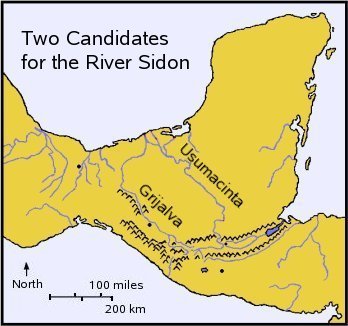 |
Figure 9. Two Rivers.
2.2 The Proposed Solution
The first part of the proposed solution is to note that in the ancient world, or even today in any
primitive area, the first rule of traveling without a road is to follow a stream or river if possible. The fact that we are
told that the Sidon had its headwaters near the Wilderness Strip is tantamount to saying that their
instructions were something like, "Find a headwater tributary of the Sidon and simply follow it for
about x (some number given) days until you come to a huge city on its west side. You can't miss it." If that were the
case then about the only explanation of their confusion is that they followed the wrong river, which
also had headwaters in that same area, unknown to the grandfathers giving instructions, who had
come the other way. There are more details to the solution, but first let's look at a real map.
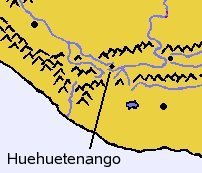 |
Figure 10. Intermingled Headwaters near the modern city of Huehuetenango.
Turning to the map of Mesoamerica, sure enough, we find two rivers both of which are good
candidates for the River Sidon, and they both have their headwaters nearly intermingled in a pass
that traverses both of the candidates for the Narrow Strip of Wilderness. Today they are called the
Grijalva and Usumacinta Rivers, as illustrated in Figure 9, with the proximity of their headwaters detailed in
Figure 10. This map is slightly more detailed than Norman's and was produced from combining
the information from several maps from encyclopedias. To me this is a compelling find in support
of the Book of Mormon. Rather than being surprised to find two similar rivers, the account tacitly
predicts there must be at least two such rivers. Again we could ask, where else in the western
hemisphere are there two large rivers which begin near each other in a coast-to-coast east-west
mountain range, flow in similar directions through similar highland and lowland areas, and hence
could easily be mistaken for each other. Much is implied in a careful reading of any account, but it
is tough to believe that an unschooled youth could come up with such an implied puzzle which has
an ideal solution on a real map, only to be discovered a century afterward.
If there had only been one candidate for the River Sidon, Book of Mormon archaeology would
probably have progressed much further by now. Because there are supporters for each of these
rivers, the efforts have been divided, and hence we are unsure of just where Zarahemla was
located. With all our modern technology, we have been almost as confused as Limhi's expedition.
M. Wells Jakeman favored the Usumacinta River, whereas John L. Sorenson, head of the BYU
Dept. of Anthropology from 1978-1986, favored the Grijalva because the archaeology is better
there. He has proposed that the ruins at Santa Rosa were Zarahemla. Most researchers have
followed his lead. Garth Norman, however, has maintained all along that the Usumacinta is indeed
the correct solution.
The one thing on which most researchers agree, however, is the location of the Land of
Desolation, and the area of several destroyed Olmec cities which might have been confused with
Zarahemla. The principal candidates seem to be La Venta, San Lorenzo, and Tres Zapotes.
Now let us return to the puzzle, and compare each of these two proposed solutions.
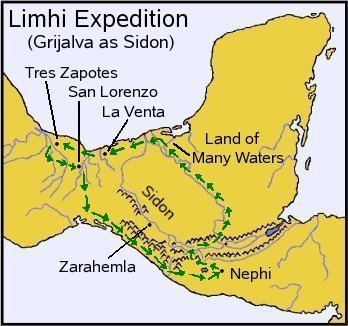 |
Figure 11. The Grijalva River as the Sidon.
2.3 The Grijalva as Sidon
If Zarahemla is located at Santa Rosa on the Grijalva, then the search party would have been
expecting a journey of about a week or two. They took some tributary of the Usumacinta by
mistake and ended up in the lowland "land of many waters" near its outlet to the sea, after some
3-4 weeks. Then, after encountering the sea and no Zarahemla, they went westward for a week until
encountering the Jaredite ruins. On the way home, the could not have come along the Grijalva, or
they would have found the real Zarahemla, so perhaps they came south across the isthmus and
followed the coastline back to where they could recognize the rest of the way home. Or they could
have retraced their path all the way back. Figure 11 illustrates this scenario, with the path of the
Limhi Expedition shown starting at Nephi, going along the Usumacinta to a land of many waters,
discovering the ruined Jaredite cities, and then returning home by the coastal option.
Many researchers have accepted this scenario, but to me it has serious problems for the scouts not
to have known that the city was not Zarahemla. First, the trip home, even if they had gone directly
with no wandering would have been more than twice as far as they would have expected. Second,
if Zarahemla was near Santa Rosa, why would they have thought that a city near the ocean could
have been Zarahemla? That whole lowland area by the sea is a "land of many waters" from the
mouths of the Usumacinta all the way over past Tres Zapotes. Third, if Zarahemla were so close to
Nephi, it is hard to believe that it was there for at least two centuries without being discovered by
the Nephites and Lamanites.
2.4 The Usumacinta as Sidon
Now consider the other possibility, that the Sidon was the Usumacinta, and that the city of
Zarahemla was in the lowlands, in a the land of many waters. That is Norman's proposal, but he
only has the general area of Zarahemla predicted, roughly as shown by the large fuzzy spot in
Figure 12 (it actually should be even larger, but that was the biggest my computer could draw).
The archaeology remains to be done in that area to discover the exact location, but this is science at
its best, when it predicts where something will be found.
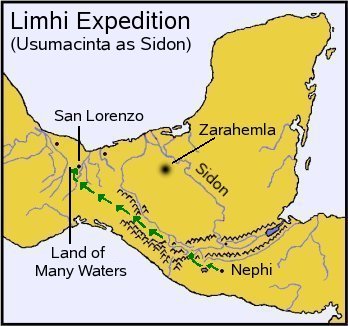 |
Figure 12. The Usumacinta River as the Sidon.
Again the arrows show the proposed path of the trip from Nephi to Desolation. The party took the
wrong tributary and followed the Grijalva river until it comes to an impassible gorge. Then it went
northwestward looking for the river, suggesting that they knew that the Sidon flowed in a
northwestward direction. Instead, they found the river leading to San Lorenzo, which was at that
time a destroyed Olmec (Jaredite) city. It would have been found in exactly the same kind of
lowlands and in a land of many waters as they knew Zarahemla was located, and at about the
expected distance from Nephi, and on the west side of the river. They would not have even
needed to continue on to the sea. Those ruins are in the Narrow Neck, and yet they would not
have even needed to know that there was an isthmus there. Here is the solution in Garth Norman's
own words (names and numbers in parentheses refers to his map):
"They started at the highland valley of Huehuetenango (Cumeni, 34) where the
headwaters of the Usumacinta/Sidon and the Grijalva meet. They took the wrong
river, traveled north down the Grijalva instead of east on the Usumacinta tributary.
When they reached the impassable Sumidaro gorge (later David crossing, 35), they
continued northwest thru the Chiapas depression, dropped into the lowlands of
Tabasco/Bountiful to get back on the Grijalva, but ended up on the Rio
Coatzacoalcos which they mistook for the Sidon. There they found the
Olmec/Jaredite ruins westward from San Lorenzo thru the southern
Veracruz/Cumorah zone that appeared to them to be Zarahemla. The coastal tropical
lowlands in Veracruz matches the coastal lowlands of Zarahemla in the Usumacinta
Palenque district. There could not have been a better set of circumstances to make
the fatal mistake, and there could hardly be a stronger geographic historic witness
for the authenticity of Mormon's record in Mesoamerica."[6]
To me, Norman's argument is compelling, pending the actual discovery of the ruins of Zarahemla.
My personal expertise is not in archaeology, but rather in puzzle-solving in general, so to me this is
the most likely correct answer to the puzzle. Their original instructions to find Zarahemla would
have been something like, "Find a tributary of the Sidon near Cumeni and follow it downstream
for about 15-20 days until you come to a large city on the west side of the river in a lowland area of
many waters." It explains how the trip was about the same distance to San Lorenzo as they had
expected to Zarahemla, it was found west of a large river in a similar lowland setting as Zarahemla,
and it also explains why the detail that they had found a land of many waters was included. They
could have returned by retracing their journey, so there would have been no trouble returning
home. This appears to be an excellent solution to the puzzle, but it is only one aspect of Norman's
research. Let us turn briefly to his section on linguistics.
3. Linguistic Clues
In addition to the archaeological and geographical evidence, Garth Norman has included in his
work some twenty locations where the modern names have roots which can be traced to either
Hebrew or Nahuatl words of the same meaning as his proposed Book of Mormon locations.
His list includes examples like "Sidon" being very similar to the Hebrew word for fishery
(Tsidon), and that Usumacinta has been deciphered from a Maya glyph to mean "fish river." He
notes that in the area where King Lamoni might have settled in Jershon, there is an ancient Maya
city in Belize called "Lamani."
 |
Figure 13. Tabasco is a state of Mexico.
This is not an area of my expertise, but allow me to at least comment on what little I could verify
for myself of his claims. His list of correlated names includes the proposal that "Tabasco," the
name of the state of Mexico where he believes the land of Bountiful was (see Figure 13 for a map
of the states of Mexico). He proposes that "tabasco" comes from both Hebrew and Nahuatl roots
meaning "Bountiful," as was reported in an earlier Meridian Magazine article.[7] If correct, that
find seems incredibly important. It is as if the archaeologist traveled to Tabasco looking for the
clues that it might have been the Land of Bountiful, and as he entered, the sign on the road said,
"Entering Bountiful."
Nahuatl is beyond my ken, but I have Strong's concordance of the Hebrew Old Testament, and
can easily check on his Hebrew claim. The English word "bountiful" appears twice in the Old
Testament. In Proverbs 22:9, it is translated from the Hebrew word "towb," and in Isaiah 32:5 it
is translated from "showa."[8] Norman suggests that the name Tabasco might be a combination of
both words. To me he has won the point just with the first word. "Tob" is close enough to Tabasco to merit further research. His linguistic finds alone could prove to be very important in
determining Book of Mormon geography. For reference, Figure 14 shows the geographical and
political features together on one map.
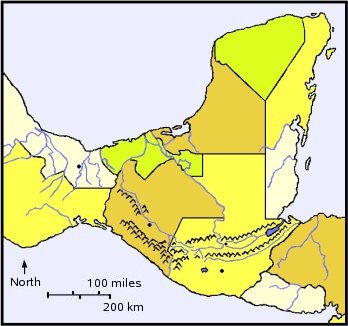 |
Figure 14. Geographical and Political Map.
4. Conclusion
When one tries to fit the history given in the Book of Mormon to a map of the western hemisphere,
one finds an excellent match geographically, archaeologically, culturally, and linguistically to the
area of southern Mexico and Guatemala as being the setting for most of the record. Most modern
scholars have agreed on the general area, with the main difference of opinion being the choice of
which river best matches the description of the River Sidon. The current favorite tends to be the
Grijalva River, but Garth Norman has made a strong logical argument in favor of the Usumacinta.
It best explains how the Limhi expedition could mistake a destroyed Jaredite city for Zarahemla.
But the final verdict must await archaeological evidence before one can be certain. In any case,
Norman appears to have created the best map to date pinpointing where many events might well
have occurred. Moreover, he has added linguistic evidence and detailed references. In the opinion
of this reviewer, none of the other attempts at such a map have done so well. Having a map to
follow the action can really help bring the story to life and to remember the events by visualizing
just where they probably occurred.
Notes
- Norman, V. Garth, Book of Mormon - Mesoamerican Historic Geography (American Fork,
Utah: Ancient America Foundation, 2006), being the Study Text for the Mesoamerica & Book of
Mormon Lands Map available at www.ancientamerica.org/library/media/HTML/7hvlmli5/book%20of%20mormon%20map.htm
- Washburn, J.N., Book of Mormon Guidebook (1968), p. 135.
- See Allen, Joseph L., Exploring the Lands of the Book of Mormon (Orem, Utah: S.A.
Publishers, 1989) for the best summary of this entire subject. It is thorough, covers many aspects
of the field, and is probably the most objective work at its time.
- Norman selects the southern mountain range as the wilderness strip, which is very important to his placing of Helam, the town that Alma founded for his believers.
- See puzzles number 8 and 9 on my webpage entitled "My Favorite Logic Puzzles" at
www.johnpratt.com/items/puzzles/logic_puzzles.html.
- Norman, Mesoamerican Historic Geography , p.7.
- Norman, V. Garth, "A Mesoamerican Place Name for Bountiful?" Meridian Magazine (18 July 2006, republished 20 Sep 2010).
- Strong, James, The Exhaustive Concordance to the Bible (McLean, Virginia: MacDonald Pub.), p. 139, referencing his Hebrew words 2896 and 7771.














